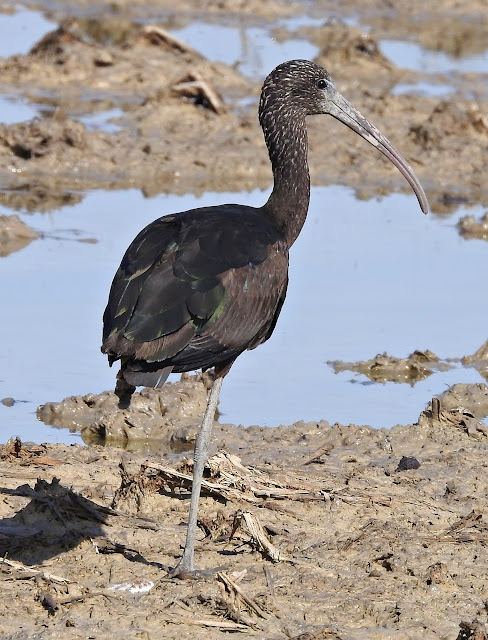The Glossy Ibis, Plegadis falcinellus, is a wading bird of the family Threskiornithidae, known for its striking, sickle-shaped bill. This mid-sized ibis measures 48–66 cm in length, with a wingspan of 80–105 cm. Breeding adults boast reddish-brown bodies and iridescent bottle-green wings, while non-breeders and juveniles display a more subdued coloration. The species is characterized by a brownish bill, dark facial skin with blue-gray to cobalt blue borders, and red-brown legs. In flight, the ibis extends its neck and exhibits a graceful V formation.
When identifying the Glossy Ibis, look for its unique glossy feathers and the distinct shape of its bill. The bird's flight pattern is also a telltale sign, as it flies with its neck outstretched, unlike herons. Listen for its various croaks and grunts, particularly the hoarse grrrr sound during the breeding season.
The Glossy Ibis favors freshwater or brackish wetlands with tall, dense emergent vegetation such as reeds, papyrus, or rushes, and low trees or bushes. It can also be found in lagoons, floodplains, wet meadows, swamps, reservoirs, sewage ponds, rice paddies, and irrigated farmland. Coastal habitats like estuaries and salt marshes are less common for this species.
This ibis is the most widespread of its kind, breeding in warm regions across Europe, Asia, Africa, Australia, and the Americas. It is migratory, with European birds wintering in Africa and North American birds migrating southward. The species has been expanding its range, with increasing numbers in Europe and successful breeding in Britain as of 2022.
The Glossy Ibis is known for its nomadic tendencies and dispersal movements post-breeding. Northern populations are migratory, traversing vast distances such as the Sahara Desert. The species nests in mixed colonies and forms large flocks during migration and winter. It often roosts communally with other species, sometimes in trees far from feeding areas.
The Glossy Ibis is relatively quiet, but it does produce a range of vocalizations, including croaks and grunts. A distinctive hoarse grrrr can be heard during the breeding season.
Nesting occurs above water on platforms of twigs and vegetation, with both parents incubating the 3 to 4 eggs laid. Chicks leave the nest after about a week but are fed by parents for another 6 to 7 weeks, fledging around 28 days old.
The ibis's diet is seasonal and opportunistic, feeding on a variety of prey such as insects, annelids, molluscs, crustaceans, and occasionally fish, amphibians, lizards, small snakes, and nestling birds.
The Glossy Ibis is classified as Least Concern by the IUCN. However, it faces threats from habitat degradation and loss due to drainage, salinity changes, groundwater extraction, and invasive plant species. It is protected under the Agreement on the Conservation of African-Eurasian Migratory Waterbirds (AEWA).































